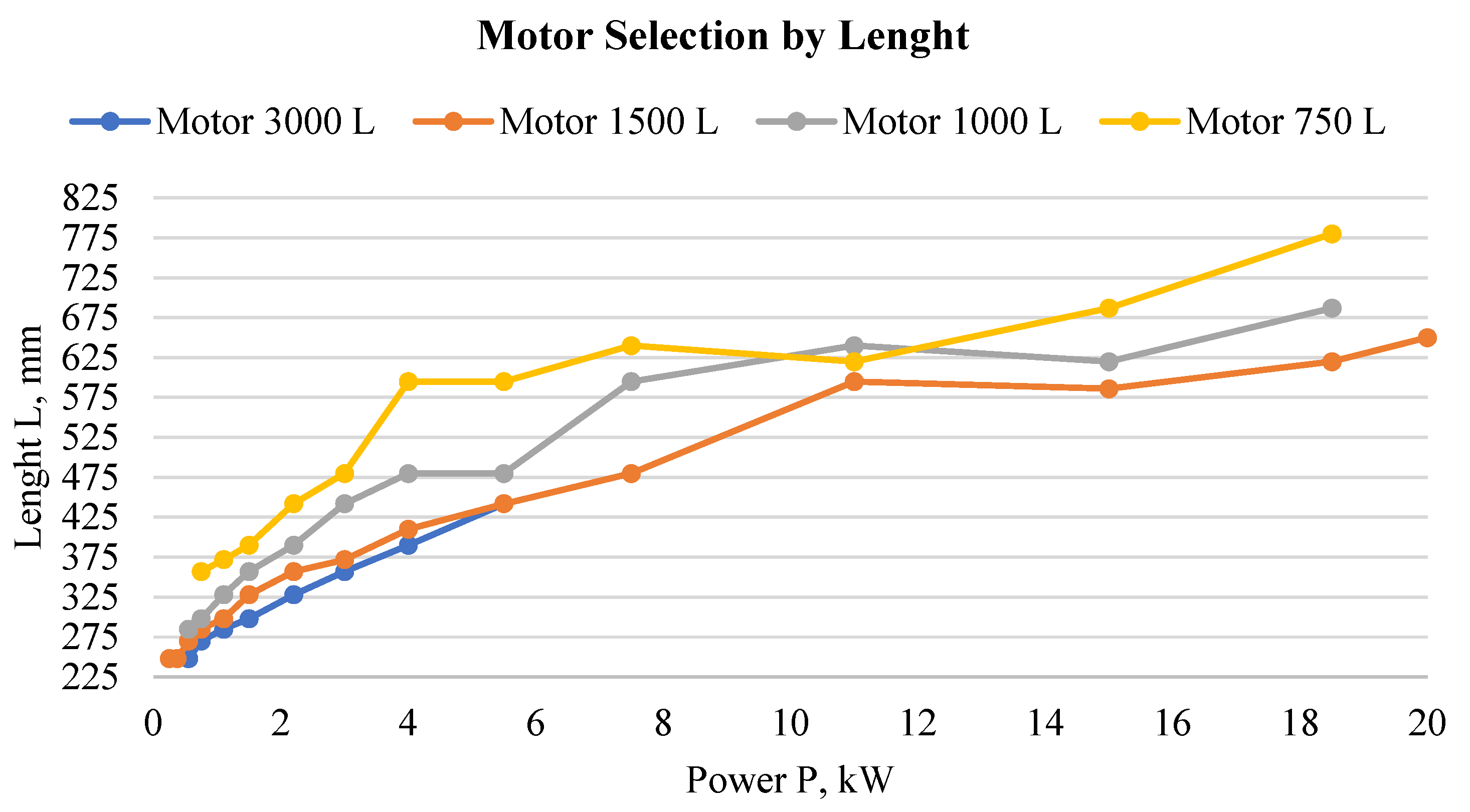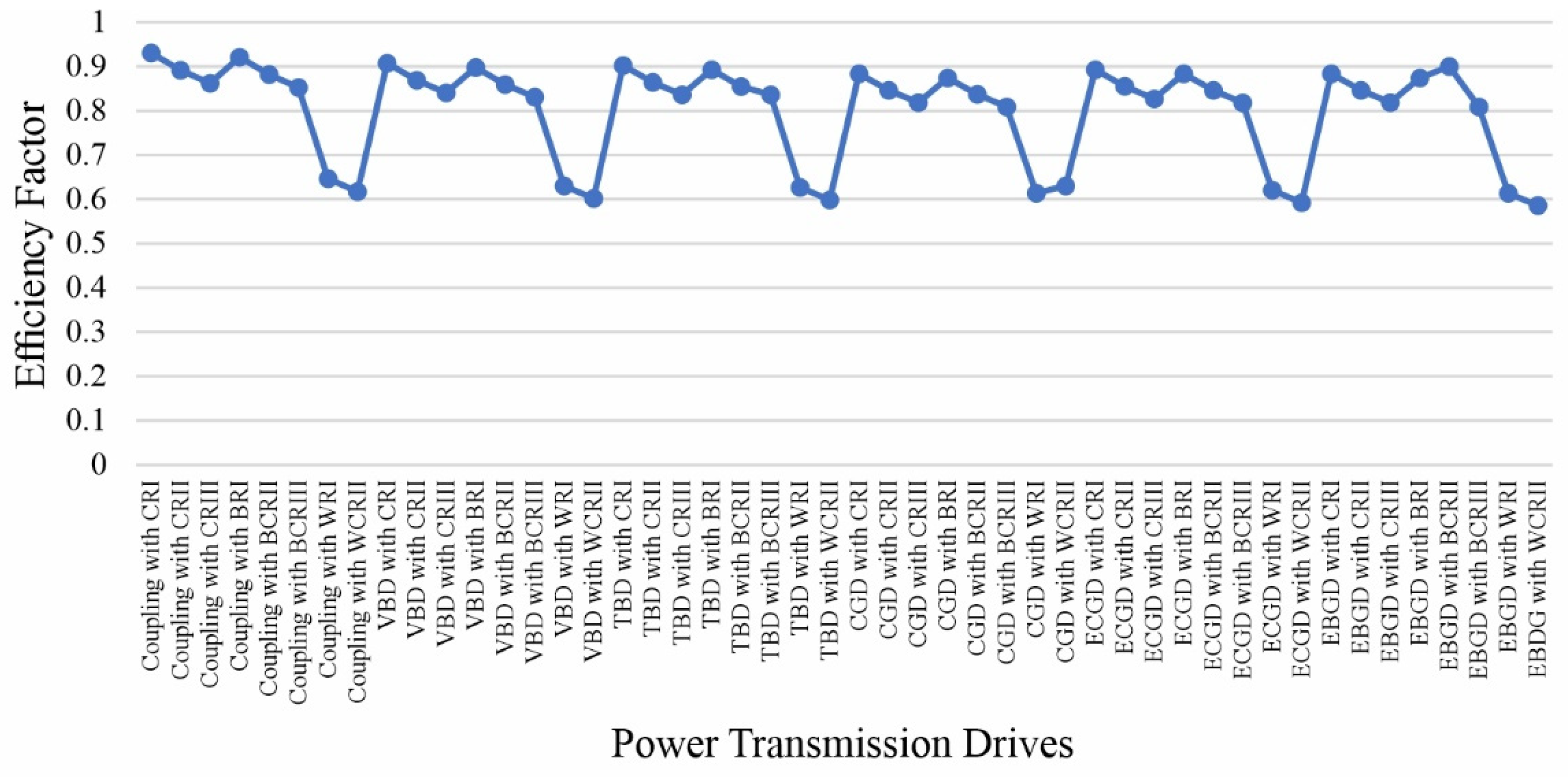Graphical Dependencies and Mechanical Unit Selection for Driving a Work Machine †
Abstract
1. Introduction
- electric motor mass as a function of its power—for motors with 750, 1000, 1500, and 3000 ;
- the length of the electric motor as a function of its power—for motors with 750, 1000, 1500, and 3000 ;
- the total gear ratio of the drive as a function of the type of mechanical system;
- the total efficiency coefficient of the drive as a function of the type of mechanical system.
2. Materials and Methods
3. Conclusions
Funding
Institutional Review Board Statement
Informed Consent Statement
Data Availability Statement
Conflicts of Interest
Abbreviations
| VBD | V-belt drive |
| TBD | Toothed belt drive |
| CGD | Chain gear drive |
| ECGD | External Cylindrical Gear Drive |
| EBGD | External Bevel Gear Drive |
| CRI | Single Stage Cylindrical Reducer |
| CRII | Double Stage Cylindrical Reducer |
| CRIII | Triple Stage Cylindrical Reducer |
| BRI | Single Stage Bavel Reducer |
| BCRII | Double Stage Bevel Cylindrical Reducer |
| BCRIII | Triple Stage Bevel Cylindrical Reducer |
| WRI | Single Stage Worm Reducer |
| WCRII | Double Stage Worm Cylindrical Reducer |
| EF | Efficiency Factor |
References
- Jiang, T.; Wang, Z.; Ren, Z.; Liu, G.; Ren, F. Analysis on mechanical characteristics of brake wheel and brake shoe of elevator traction machine. J. Phys. Conf. Ser. 2021, 2125, 012046. [Google Scholar] [CrossRef]
- Gazor, H.R.; Roustapour, O.R. Comparison of mechanical Z-shape elevator operation for handling seed corn. Agric. Eng. Int. CIGR J. 2021, 23, 271–278. [Google Scholar]
- Gavryukov, A.; Kolesnikov, M.; Sikorsky, I.; Zapryvoda, A.; Volters, A.; Samoilenko, M. Devising a procedure for calculating the belt tension of a conveyor with a stopped drive when changing the transportation length. East.-Eur. J. Enterp. Technol. 2025, 133, 22. [Google Scholar] [CrossRef]
- Polishchuk, L.; Piontkevych, O.; Burdeinyi, M.; Trehubov, V. Justification for choosing the type of belt conveyor drive. Bull. Mech. Eng. Transp. 2024, 1, 115–122. [Google Scholar] [CrossRef]
- Bufalari, L.; Anselmi, E.; Rinchi, M.; Howard, K.; Talluri, L.; Fiaschi, D. Mechanical design and manufacture of a boundary layer pump. E3S Web Conf. 2023, 414, 03016. [Google Scholar] [CrossRef]
- Soares, J.D.; Paula, M.O.; Carneiro, A.C.O.; Costa, L.J.; Oliveira, A.C.; Pereira, B.L.C. Parameters to determine mechanical strength of charcoal in a hydraulic press. Rev. Bras. De Ciências Agrárias 2021, 16, e9096. [Google Scholar] [CrossRef]
- Babenko, D.; Dotsenko, N.; Gorbenko, O. Study of structural and kinematic characteristics of an energy-efficient oil press. Ukr. Black Sea Reg. Agrar. Sci. 2024, 28, 41–54. [Google Scholar] [CrossRef]
- Ding, Y.; Zhang, C.; Ruan, C.; Tong, C.; Ruan, J. Study on mechanical efficiency of 65 ml/r fuel pump and its piston optimization. Adv. Mech. Eng. 2023, 15, 1–15. [Google Scholar] [CrossRef]
- Yaghoubi, M.; Tavakoli, H. Mechanical Design of Machine Elements by Graphical Methods; Springer: Cham, Switzerland, 2022; Volume XV, 285p, ISBN 978-3-031-04328-4. [Google Scholar] [CrossRef]
- Rika, S.; Hristovska, E.; Chalamani, S.; Sovreski, Z.; Stavreva, S.; Kuzmanov, I. Analysis and Optimization of Electric Motor Power for Rubber Belt Conveyors. Int. Trans. J. Eng. Manag. Appl. Sci. Technol. 2025, 16, 1. [Google Scholar] [CrossRef]
- Prasetia, A.M.; Sartika, L.; Samanta, R.; Sanjaya, D. Implementation of Variable Speed Drive as Starting Control of Three Phase Induction Motor. J. Edukasi Elektro 2024, 8, 2. [Google Scholar] [CrossRef]
- Li, W.; Chai, Z.; Wang, M.; Hu, X.; Guo, Y. Online Identification and Verification of the Elastic Coupling Torsional Stiffness. Shock Vib. 2016, 2016, 2016432. [Google Scholar] [CrossRef]
- Zhao, B.; Zhao, Y.; Feng, J.; Peng, X. Numerical and experimental investigation of the torsional stiffness of flexible disc couplings. Int. J. Mech. Sci. 2016, 114, 207–216. [Google Scholar] [CrossRef]
- Hristov, H.; Tenev, S.; Mehmedov, I.; Bankova, A. Hysteresis Energy Caracteristic of SEGME-type in Flexible Coupling. In Proceedings of the 4th International Conference on Communications, Information, Electronic and Energy Systems, CIEES 2023, Plovdiv, Bulgaria, 23–25 November 2023; pp. 1–6. [Google Scholar] [CrossRef]
- Dinh, V.-T.; Tran, H.-D.; Tran, Q.-H.; Vu, D.-B.; Vu, D.; Vu, N.-P.; Nguyen, T.-T. Multi-Objective Optimization of a Two-Stage Helical Gearbox Using MARCOS Method. Designs 2024, 8, 53. [Google Scholar] [CrossRef]
- Danh, T.; Thanh, D.; Danh, B.; Cuong, N.; Tung, L. Optimization of a Two-stage Bevel Helical Gearbox using Multiple Objectives to Increase Efficiency and Reduce Gearbox Bottom Area. WSEAS Trans. Appl. Theor. Mech. 2024, 19, 11. [Google Scholar] [CrossRef]
- Elprom. Available online: https://www.elprommotors.com/en (accessed on 10 April 2025).
- Spektor, M. Machine Design Elements and Assemblies; Industrial Press, Inc.: South Norwalk, CT, USA, 2018; 480p, ISBN 978-0831136192. [Google Scholar]
- Tiruneh, A. Introduction for Designing Machine Element: Machine Design; LAP LAMBERT Academic Publishing: Saarbrücken, Germany, 2020; 60p. [Google Scholar]
- Rodrigues, S. Machine Elements; Discovery Publishing House (India): New Delhi, India, 2024; 254p. [Google Scholar]
- Rajkumar, E.; Bikash, R. Basic Elements of Machine Design; Namya Press: Delhi, India, 2024; 333p. [Google Scholar]
- Childs, P.; Masen, M. Mechanical Design Engineering Handbook, Butterworth-Heinemann, 3rd ed.; Elsevier: London, UK, 2024; 880p, ISBN 9780443220777. [Google Scholar]
- Modul PLC. Available online: https://www.modul-biala.com/en/ (accessed on 10 April 2025).







| № | Connecting Link | Min Ratio | Max Ratio | Efficiency Factor |
|---|---|---|---|---|
| 1. | Coupling | 1 | 1 | 0.98 |
| 2. | V-belt Drive (VBD) | 2 | 7 | 0.955 |
| 3. | Toothed Belt Drive (TBD) | 2 | 12 | 0.95 |
| 4. | Chain Gear Drive (CGD) | 2 | 8 | 0.93 |
| 5. | External Cylindrical Gear Drive (ECGD) | 3 | 10 | 0.94 |
| 6. | External Bevel Gear Drive (EBGD) | 2 | 6 | 0.93 |
| Gear Reducer | Min Ratio | Max Ratio | Efficiency Factor |
|---|---|---|---|
| Single-Stage Cylindrical Reducer (CRI) | 1.25 | 5.6 | 0.95 |
| Double-Stage Cylindrical Reducer (CRII) | 6.3 | 28 | 0.91 |
| Triple-Stage Cylindrical Reducer (CRIII) | 22.4 | 112 | 0.88 |
| Single-Stage Bavel Reducer (BRI) | 2 | 6 | 0.94 |
| Double-Stage Bevel Cylindrical Reducer (BCRII) | 5 | 14 | 0.9 |
| Triple-Stage Bevel Cylindrical Reducer (BCRIII) | 12.5 | 80.9 | 0.87 |
| Single-Stage Worm Reducer (WCRI) | 10 | 60 | 0.66 |
| Double-Stage Worm Cylindrical Reducer (WCRII) | 50 | 400 | 0.63 |
Disclaimer/Publisher’s Note: The statements, opinions and data contained in all publications are solely those of the individual author(s) and contributor(s) and not of MDPI and/or the editor(s). MDPI and/or the editor(s) disclaim responsibility for any injury to people or property resulting from any ideas, methods, instructions or products referred to in the content. |
© 2025 by the author. Licensee MDPI, Basel, Switzerland. This article is an open access article distributed under the terms and conditions of the Creative Commons Attribution (CC BY) license (https://creativecommons.org/licenses/by/4.0/).
Share and Cite
Tenev, S.I. Graphical Dependencies and Mechanical Unit Selection for Driving a Work Machine. Eng. Proc. 2025, 104, 95. https://doi.org/10.3390/engproc2025104095
Tenev SI. Graphical Dependencies and Mechanical Unit Selection for Driving a Work Machine. Engineering Proceedings. 2025; 104(1):95. https://doi.org/10.3390/engproc2025104095
Chicago/Turabian StyleTenev, Stefan Ilchev. 2025. "Graphical Dependencies and Mechanical Unit Selection for Driving a Work Machine" Engineering Proceedings 104, no. 1: 95. https://doi.org/10.3390/engproc2025104095
APA StyleTenev, S. I. (2025). Graphical Dependencies and Mechanical Unit Selection for Driving a Work Machine. Engineering Proceedings, 104(1), 95. https://doi.org/10.3390/engproc2025104095





